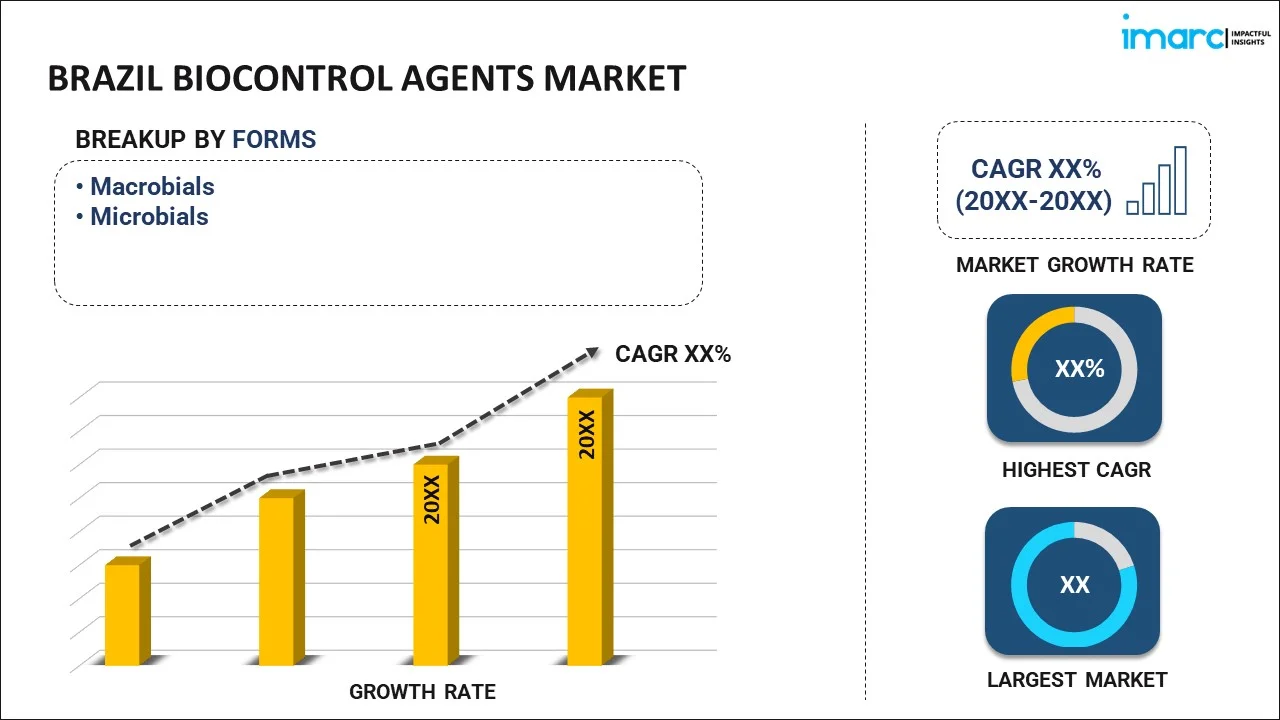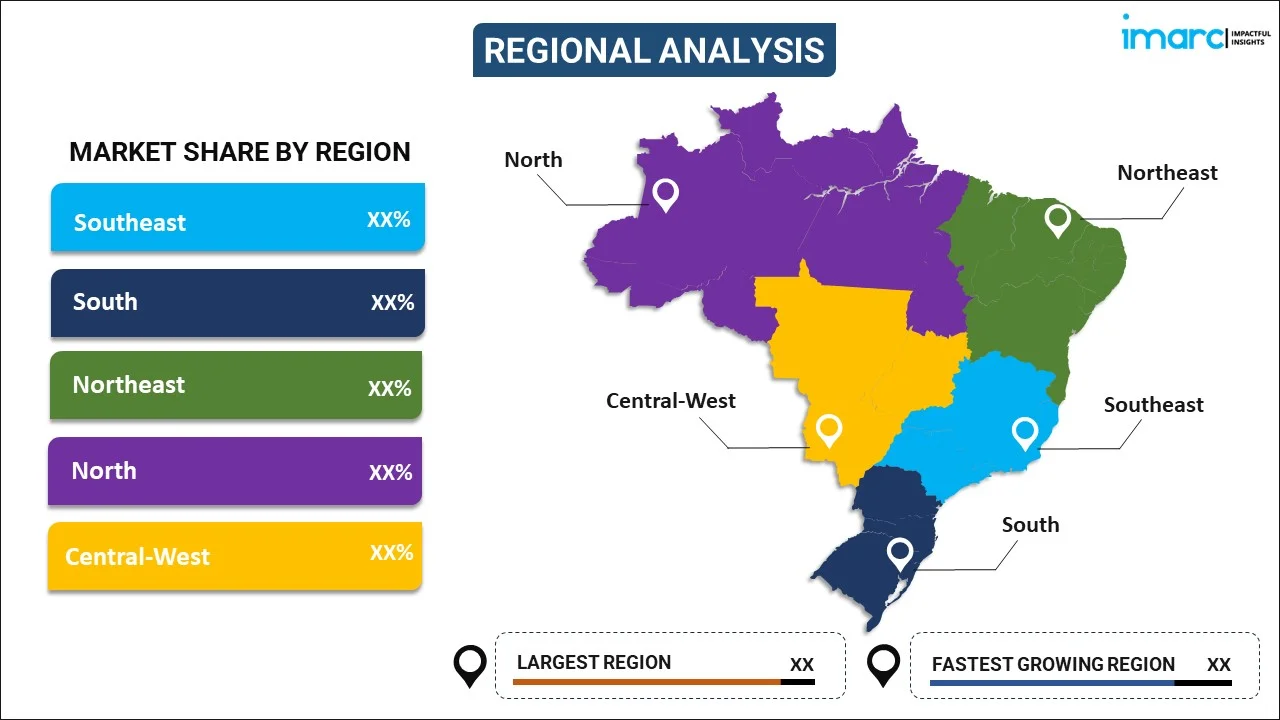
Brazil Biocontrol Agents Market Report by Form (Macrobials, Microbials), Crop Type (Cash Crops, Horticultural Crops, Row Crops), and Region 2025-2033
Market Overview:
Brazil biocontrol agents market size reached USD 87.8 Million in 2024. Looking forward, IMARC Group expects the market to reach USD 179.4 Million by 2033, exhibiting a growth rate (CAGR) of 8.3% during 2025-2033. The growing awareness about the environmental impact of chemical pesticides, favorable government initiatives, rising crop diversity, growing consumer demand for sustainable products, ongoing research and development, and meeting international quality and safety standards represent some of the key factors driving the market.
|
Report Attribute
|
Key Statistics
|
|---|---|
|
Base Year
|
2024 |
|
Forecast Years
|
2025-2033
|
|
Historical Years
|
2019-2024
|
| Market Size in 2024 | USD 87.8 Million |
| Market Forecast in 2033 | USD 179.4 Million |
| Market Growth Rate (2025-2033) | 8.3% |
Biocontrol agents refer to naturally occurring organisms or substances that are harnessed to control and manage pests, diseases, and unwanted organisms in a sustainable and eco-friendly manner. These agents include various beneficial insects, nematodes, fungi, bacteria, and certain plants. One of the key advantages of biocontrol agents is their ability to target specific pests or pathogens, minimizing harm to non-target organisms and reducing the need for chemical pesticides. For instance, ladybugs are well-known biocontrol agents that feed on aphids, helping to protect crops from infestations. Similarly, parasitic wasps lay their eggs in the larvae of certain insect pests, effectively preventing their population growth. Biocontrol agents have gained popularity in modern agriculture due to their compatibility with integrated pest management (IPM) strategies, which aim to optimize pest control while minimizing environmental impacts. The use of biocontrol agents aligns with sustainable farming practices and reduces the reliance on chemical interventions, thereby promoting healthier ecosystems and more resilient agricultural systems.
Brazil Biocontrol Agents Market Trends:
Growing awareness about the environmental impact of chemical pesticides has led to a shift toward more sustainable agricultural practices. Biocontrol agents offer a greener alternative, as they are less harmful to ecosystems and reduce chemical pollution. Additionally, Brazil is a major producer of a wide range of crops, from soybeans and sugarcane to coffee and citrus fruits. The diversity of crops creates opportunities for biocontrol agents to address specific pest problems in different regions and agricultural sectors. Other than this, the agricultural exports of the region are crucial to its economy. Meeting international quality and safety standards is essential for these exports. Biocontrol agents help ensure compliance with stringent regulations, boosting the country's export potential. Besides this, pests can develop resistance to chemical pesticides over time, declaring them ineffective. Biocontrol agents provide an alternative approach that can help manage resistant pest populations effectively. In line with this, as consumers become more health conscious and environmentally aware, there is a growing demand for food produced with minimal chemical residues. As a result, farmers are adopting biocontrol agents to meet this demand. Moreover, ongoing research in biocontrol agents has led to the discovery of new and more effective strains of beneficial organisms and innovative application methods, which are expected to create a favorable market outlook in the near future.
Brazil Biocontrol Agents Market Segmentation:
IMARC Group provides an analysis of the key trends in each segment of the market, along with forecasts at the country level for 2025-2033. Our report has categorized the market based on form and crop type.
Form Insights:

- Macrobials
- Entamopathogenic Nematodes
- Parasitoids
- Predators
- Microbials
- Bacterial Biocontrol Agents
- Fungal Biocontrol Agents
- Others
The report has provided a detailed breakup and analysis of the market based on the form. This includes macrobials (entamopathogenic nematodes, parasitoids, and predators) and microbials (bacterial biocontrol agents, fungal biocontrol agents and others).
Crop Type Insights:
- Cash Crops
- Horticultural Crops
- Row Crops
A detailed breakup and analysis of the market based on the crop type have also been provided in the report. This includes cash crops, horticultural crops, and row crops.
Regional Insights:

- Southeast
- South
- Northeast
- North
- Central-West
The report has also provided a comprehensive analysis of all the major regional markets, which include Southeast, South, Northeast, North, and Central-West.
Competitive Landscape:
The market research report has also provided a comprehensive analysis of the competitive landscape in the market. Competitive analysis such as market structure, key player positioning, top winning strategies, competitive dashboard, and company evaluation quadrant has been covered in the report. Also, detailed profiles of all major companies have been provided.
Brazil Biocontrol Agents Market Report Coverage:
| Report Features | Details |
|---|---|
| Base Year of the Analysis | 2024 |
| Historical Period | 2019-2024 |
| Forecast Period | 2025-2033 |
| Units | Million USD |
| Scope of the Report | Exploration of Historical and Forecast Trends, Industry Catalysts and Challenges, Segment-Wise Historical and Predictive Market Assessment:
|
| Forms Covered |
|
| Crop Types Covered | Cash Crops, Horticultural Crops, Row Crops |
| Regions Covered | Southeast, South, Northeast, North, Central-West |
| Customization Scope | 10% Free Customization |
| Post-Sale Analyst Support | 10-12 Weeks |
| Delivery Format | PDF and Excel through Email (We can also provide the editable version of the report in PPT/Word format on special request) |
Key Questions Answered in This Report:
- How has the Brazil biocontrol agents market performed so far and how will it perform in the coming years?
- What has been the impact of COVID-19 on the Brazil biocontrol agents market?
- What is the breakup of the Brazil biocontrol agents market on the basis of form?
- What is the breakup of the Brazil biocontrol agents market on the basis of crop type?
- What are the various stages in the value chain of the Brazil biocontrol agents market?
- What are the key driving factors and challenges in the Brazil biocontrol agents?
- What is the structure of the Brazil biocontrol agents market and who are the key players?
- What is the degree of competition in the Brazil biocontrol agents market?
Key Benefits for Stakeholders:
- IMARC’s industry report offers a comprehensive quantitative analysis of various market segments, historical and current market trends, market forecasts, and dynamics of the Brazil biocontrol agents market from 2019-2033.
- The research report provides the latest information on the market drivers, challenges, and opportunities in the Brazil biocontrol agents market.
- Porter's five forces analysis assist stakeholders in assessing the impact of new entrants, competitive rivalry, supplier power, buyer power, and the threat of substitution. It helps stakeholders to analyze the level of competition within the Brazil biocontrol agents industry and its attractiveness.
- Competitive landscape allows stakeholders to understand their competitive environment and provides an insight into the current positions of key players in the market.
Need more help?
- Speak to our experienced analysts for insights on the current market scenarios.
- Include additional segments and countries to customize the report as per your requirement.
- Gain an unparalleled competitive advantage in your domain by understanding how to utilize the report and positively impacting your operations and revenue.
- For further assistance, please connect with our analysts.
 Inquire Before Buying
Inquire Before Buying
 Speak to an Analyst
Speak to an Analyst
 Request Brochure
Request Brochure
 Request Customization
Request Customization




.webp)




.webp)












